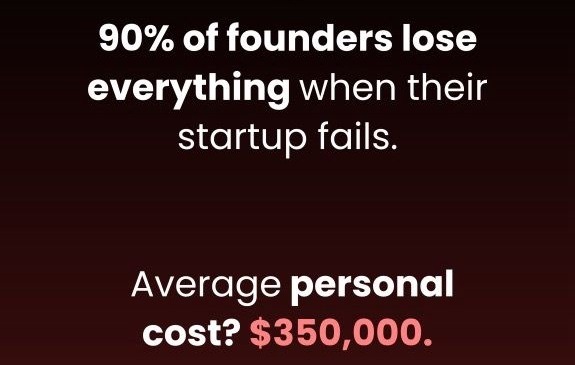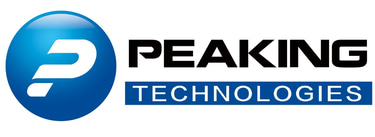Crushing Reality for Hardware Founders: Why We Need a Revolution in How We Build and Fund Innovation
That gut-wrenching statistic – 90% of founders lose everything when their startup fails, often at a personal cost of $350,000 – isn't just an abstract number. It's a stark reflection of the immense pressure and often unforgiving landscape facing entrepreneurs, particularly here in Canada.
5/14/20256 min read


That gut-wrenching statistic – 90% of founders lose everything when their startup fails, often at a personal cost of $350,000 – isn't just an abstract number. It's a stark reflection of the immense pressure and often unforgiving landscape facing entrepreneurs, particularly here in Canada. And for those daring to build in the physical world, the challenges, and consequently the failure rates, are even more pronounced.
Having navigated the treacherous waters of near-bankruptcy not once, but seven times before finally finding success with Apple, I've witnessed firsthand the systemic issues that are crippling our innovation ecosystem. The outdated risk models employed by some institutional investors, especially in Canada, are not just hindering growth; they're actively destroying futures.
The five dangerous myths I recently highlighted on LinkedIn are particularly toxic for hardware entrepreneurs:
Myth 1: "Personal guarantees protect institutional investments." For Hardware Founders, It's a Death Sentence.
The added financial burden of hardware development makes personal guarantees even more perilous. When a hardware startup falters – often due to unforeseen manufacturing delays, supply chain disruptions, or the sheer cost of iteration – the personal financial fallout for founders can be catastrophic. While a US software founder might pivot after a failure, a Canadian hardware founder is often left with nothing, their home and savings liquidated to satisfy institutional demands. This risk aversion doesn't protect investments; it decimates the very talent pool we need for future innovation.
Myth 2: "Tech startups should be evaluated like traditional businesses." Especially Absurd for Capital-Intensive Hardware.
Applying cookie-cutter risk models to hardware startups is akin to fitting a square peg in a round hole. The capital intensity, longer timelines, and inherent uncertainties of bringing a physical product to market demand a different understanding of risk and return. Expecting a linear growth trajectory and immediate profitability from a pre-revenue hardware venture is unrealistic and fundamentally misunderstands the iterative nature of innovation. Seven out of ten software startups might need to fail for the breakthroughs to occur; for hardware, that ratio can be even higher due to the added complexities.
Myth 3: "Debt financing helps startups grow faster." A Highway to Hell for Pre-Revenue Hardware.
Encouraging pre-revenue hardware startups to take on debt is particularly dangerous. The significant upfront costs and extended development cycles mean that debt without a clear path to near-term revenue can quickly become an insurmountable burden. Unlike software, where iterations can sometimes be faster and cheaper, hardware pivots often require new tooling and manufacturing setups, further exacerbating debt issues. The pressure to service debt can stifle crucial experimentation and ultimately lead to a swift and painful demise.
Myth 4: "Risk-averse investing protects the ecosystem." It Stifles the Very Roots of Hardware Innovation.
The short-term ROI focus of some institutional investors actively discourages investment in the inherently riskier but potentially high-impact field of hardware. They might shy away from the longer timelines and higher capital requirements, preferring instead to chase perceived "safer" bets. However, this risk aversion overlooks the immense value creation potential of successful hardware ventures and the critical role they play in driving technological advancement. By failing to nurture early-stage hardware startups and support repeat founders, Canada risks missing out on the next wave of transformative technologies.
Myth 5: "Stable jobs are safer than entrepreneurship." A Dangerous Illusion in the Age of AI and Automation.
This myth is particularly concerning for the future of Canadian manufacturing and the broader economy. AI and automation are poised to disrupt numerous "stable" jobs. The true stability lies in creating value, and hardware entrepreneurs are at the forefront of building tangible solutions and generating new forms of employment. By discouraging this builder mindset through a risk-averse culture and predatory investment practices, we are actively undermining our future economic resilience.


The Even Steeper Climb: Why Hardware Failure Rates Are Higher
As mentioned earlier, the journey for a hardware startup is fraught with additional challenges that contribute to even higher failure rates. The capital expenditure required for R&D, prototyping, and initial manufacturing is substantial. Navigating complex global supply chains, ensuring quality control during production, and managing inventory are all significant hurdles. The longer development cycles mean a longer period of investment without revenue, increasing the risk of running out of capital.
The Lifeline: Strategic Partnerships with Manufacturers
In this challenging landscape, one of the most critical factors for survival and success for hardware startups is forging strong, strategic partnerships with experienced manufacturers. This isn't just about finding someone to build your product; it's about building a collaborative relationship that can provide invaluable expertise and support throughout the entire product lifecycle.
Here's why partnering with the right manufacturer is paramount for hardware startups:
Access to Expertise and Experience: Established manufacturers bring years of experience in design for manufacturability (DFM), materials sourcing, production processes, and quality control. Their insights can help startups avoid costly mistakes and optimize their product for efficient and high-quality production.
Cost Optimization: Experienced manufacturers can often suggest design modifications and material alternatives that can significantly reduce production costs without compromising quality. Their established relationships with suppliers can also lead to better pricing on components.
Scalability and Flexibility: A good manufacturing partner should be able to scale production as your demand grows. They should also be flexible enough to adapt to design changes and evolving market needs.
Quality Assurance: Ensuring consistent product quality is crucial for building a strong brand and customer trust. Reputable manufacturers have robust quality control processes in place to minimize defects and ensure that your product meets the required standards.
Supply Chain Management: Navigating the complexities of global supply chains can be daunting for a startup. A manufacturing partner with established supply chain networks can help streamline the process, manage logistics, and mitigate potential disruptions.
Reduced Risk: By leveraging the expertise and infrastructure of an experienced manufacturer, startups can significantly reduce the risks associated with production, quality, and supply chain management. This allows the founding team to focus on other critical aspects of the business, such as product development, marketing, and sales.
Faster Time to Market: Partnering with a manufacturer early in the development process can help accelerate the time to market. Their input on DFM can streamline the design process, and their established production capabilities can expedite manufacturing.
Choosing the Right Partner:
Selecting the right manufacturing partner is a critical decision. Hardware startups should look for partners who:
Have experience with similar products and production volumes.
Demonstrate a commitment to quality and have robust quality control processes.
Offer transparent communication and a collaborative approach.
Are flexible and willing to adapt to the startup's evolving needs.
Have a strong track record and positive references.
A Call for Change: Fostering a True Culture of Innovation
The high failure rate of hardware startups is not just a statistic; it represents lost potential, stifled innovation, and the personal devastation of ambitious founders. While strategic partnerships with manufacturers are a crucial lifeline, they are not a panacea. We need a fundamental shift in how we view and fund innovation in Canada.
We must:
Educate institutional investors on the unique risks and rewards of deep tech and hardware ventures. Outdated risk models need to be replaced with frameworks that understand the iterative nature of innovation and the potential for exponential returns.
Discourage the predatory practice of requiring personal guarantees from early-stage tech founders. This practice stifles risk-taking and prevents talented individuals from trying again after a setback.
Promote alternative financing models that are better suited to the long development cycles and capital intensity of hardware startups. This could include patient capital, government grants specifically tailored for hardware, and innovative revenue-sharing models.
Cultivate a culture that embraces failure as a learning opportunity. We need to celebrate the lessons learned from failed ventures and support founders in their next endeavors.
Recognize the strategic importance of hardware innovation for our future economic prosperity. Investing in and supporting hardware startups is an investment in Canadian manufacturing, job creation, and technological leadership.
The path of a hardware entrepreneur is inherently challenging, but it shouldn't be paved with unnecessary obstacles created by outdated financial practices and a lack of understanding. By fostering a more supportive ecosystem that understands the unique needs of hardware ventures and the critical role of manufacturing partnerships, we can unlock a new era of Canadian innovation and build a more resilient and prosperous future. The 10% who succeed in hardware can create transformative value, but we must ensure that the 90% who face setbacks are not permanently sidelined. Their experience and lessons learned are invaluable to the future of our tech ecosystem. Let's build a Canada where ambition is nurtured, not punished.
